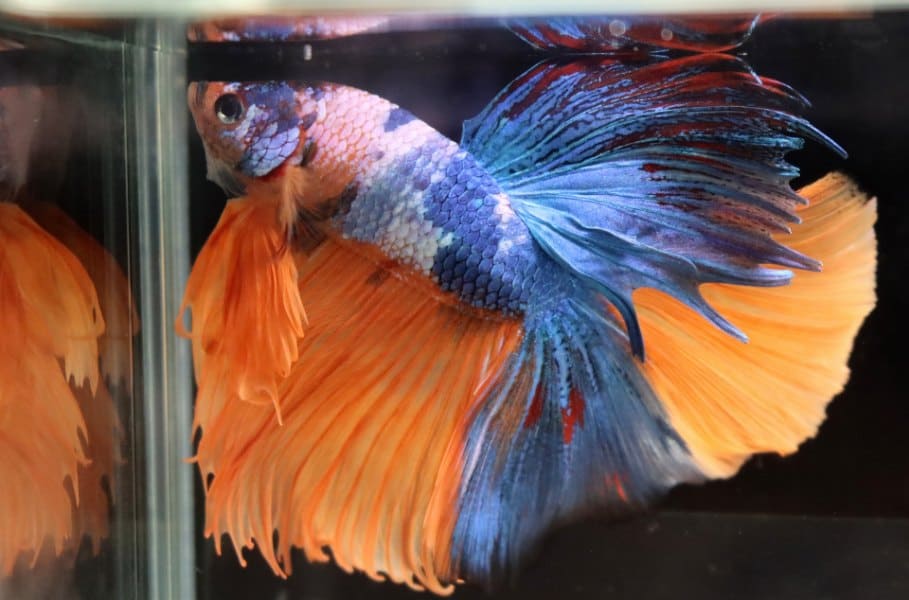Because of their beauty and personality, bettas are some of the most well-loved pets in the aquarium hobby.
Plus, with all the different Betta variants out there, you can surely find something that will strike your fancy.
One of the newer variants that are taking the aquarist hobby by storm is called the koi betta, which has unique characteristics that certainly add interest to any aquarium.
But are these fish the same as regular bettas? How do you care for them? And which type of koi bettas should you get? In this article, we’ll talk about koi bettas and all the essential information you have to know to raise one properly.
What Are Koi Bettas?
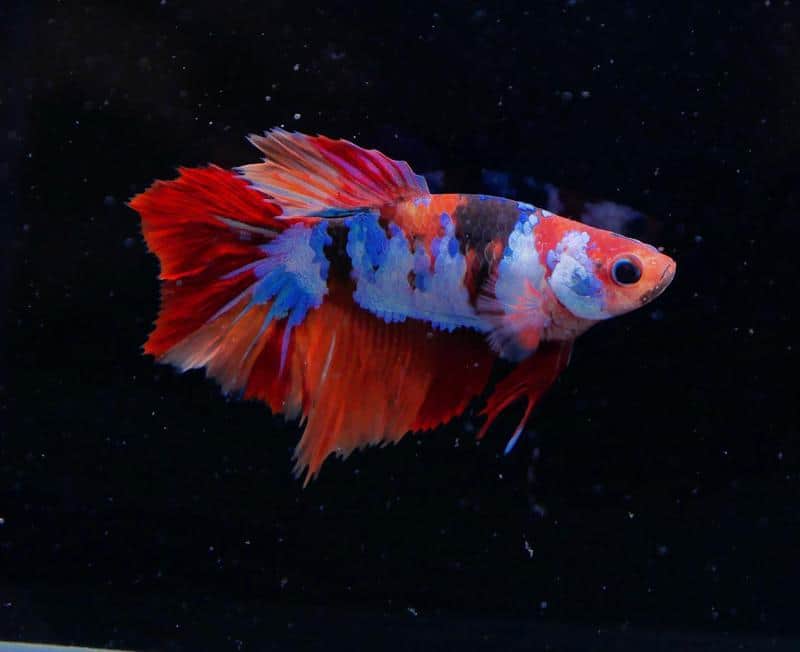
The Koi betta fish is a new arrival to the world of aquariums. Because of its striking appearance and novelty, many aquarists are starting to take notice of this fish.
But what exactly are koi bettas?
Koi bettas are a Betta variant that was developed through selective breeding. As the name implies, koi bettas were bred to resemble koi carp, which are popular ornamental fish in Japan.
To achieve this desired look, bettas that were born with this specific coloration are repeatedly bred with other Betta variants that display similar color patterns to the koi carp.
Like regular Bettas, this Betta variant is also a freshwater fish from the Gourami family. They’re called labyrinth fishes because they use their “labyrinth organ” to breathe oxygen directly from the surface, inhaling air, unlike other common fishes that live from their gills.
Bettas are native to rice fields and stagnant marshes in Southeast Asian nations like Thailand and Vietnam. They like warmer water because of their tropical origins, and they like to live in waters with a lot of vegetation.
Koi Betta Care Overview
To start raising these delightful little fishes, you should know everything you can about their care requirements, which we’ll discuss in this section.
Appearance and Size
Koi betta fish is a specific variety selectively bred to exhibit multiple vivid colors, just like koi. Koi fishes have been bred over the years to exhibit distinct colorations and patterns, often combining three or more colors. As a result, this breed is also called marble betta.
In terms of size, koi bettas have bodies that are roughly 2.5 inches long on average. Their flowing fins can reach an overall length of three inches. Females are typically smaller than males, and they also have a more rounded and plumper.
Sexing
When they’re fully matured, the difference between female koi betta and male koi betta becomes more apparent. These differences are less clear when they are young.
There are different ways you can tell a male and female koi betta fish: the following.
- Fin length. Males’ fins are typically longer than those of females. However, it all depends on the fin variety of your Koi betta e.g. halfmoon, crowntail, spadetail. You can accurately tell the difference between the two once you know the fin type of your koi betta.
- Ventral fins. Males naturally have ventral fins that are larger and longer than females, even if the rest of the fins are the same length as the females. For instance, both male and female Koi Plakats have short dorsal, anal, and caudal fins, but the male will still have longer ventral fins than their female counterparts.
- Egg spot. You can often see a white lump-like spot in mature female koi bettas located near their ventral fins. This is called a gravid or egg spot, and only females have it. Juveniles may not have it yet, though.
- Body shape. While females have a sleeker shape, males have a larger frame and a rounded skull.
- Coloration. Male koi bettas tend to have more vivid colors compared to females. This is because they use coloration to attract potential mates, so their colors need to be as eye-catching as possible.
Temperament
Male Koi bettas should ideally be kept alone since, like other male Bettas, they can be quite aggressive.
They often do well with invertebrates like bamboo shrimp and snails that are too big for them to eat.
Occasionally, you can keep mild-tempered males with other fish. The ideal tankmate must be peaceful, short-finned, and fast-swimming. They also shouldn’t be too similar in appearance to the koi betta to avoid territorial disputes.
Except during breeding, male Koi bettas should not be housed with females as they can harm or even kill the latter.
Female koi bettas can be kept in a community tank as long as the other fish are not too aggressive or large enough to eat them. You can also set up a Betta sorority, also known as all-female betta groups, which can house up to six individuals.
Lifespan
Koi Bettas can live as long as other Betta variants, which averages around 2-3 years.
There have also been recorded instances of betta fish reaching 7.5 to 10 years. If your Betta has good genetics and is living in a clean, healthy environment, the chances of living past 5 years become higher.
Tank Size
Like regular bettas, koi variants do well with a minimum tank size of 5 gallons, and ideally 10 gallons.
While it’s true that you can keep bettas in aquariums as small as 3 gallons, it’s generally not advisable. These nano aquariums are much more challenging to take care of because water quality fluctuations can hit them hard.
Additionally, if koi bettas can technically survive in cramped spaces, they won’t be able to thrive and reach their full potential.
Water Parameters
One of the most important considerations when taking care of koi betta fish is water quality. While bettas are hardy fish, they are more prone to diseases and stress if the water is dirty and doesn’t have the proper parameters to survive.
Fortunately, like their regular betta cousins, koi bettas generally don’t have any special requirements about water parameters.
It would help if you had the following relevant water quality measurements in a koi betta tank.
- Temperature: 22–26°C (71.6-78.8°F)
- pH: 0 to 8.0
- Flow rate: Calm
- Water type: Freshwater
- Live plants: Compatible
Diet
While Bettas will typically eat whatever they can fit in their little mouths, they’re actually avid hunters and thrive on high-protein food.
You can fulfill this carnivorous need by feeding them high-quality pellets or flakes as their primary food. You can also give your Koi betta fish live foods or thawed frozen foods like bloodworms, daphnia, and brine shrimp.
To keep your betta koi healthy, it’s important to give them commercial food as the mainstay of their diet. This way, you can be sure they’re getting all the nutrients they need. Fruits and vegetables won’t improve their health, unlike other common aquarium fish such as goldfish.
Treats are safe in moderation, but Koi bettas should be fed primarily with protein-based diets.
Breeding
Koi betta fish can be successfully bred in a 10-gallon aquarium by any hobbyist. Individuals under a year old are best for breeding since they are still incredibly fertile.
Before breeding, the breeding couple needs to be conditioned. The water temperature should also be at least 27°C, with the pH around 7.0. The eggs will be stored in a bubble nest that the male betta will construct.
Since the male can become hostile during the breeding season, make sure you prepare a secure hiding place for the female.
Here’s what typically happens:
- The male will circle the female and display his vivid colors. This color change happens in the breeding season, with the males’ colors becoming brighter and deeper to attract potential mates.
- The female will then release her eggs in the water while the male fertilizes them.
- The male will then spit the eggs into the bubble nest after scooping them up.
- It’s the male’s job to take care of the job. Once the eggs are secured, you can transfer the female to a different tank.
- The eggs will hatch after about 3 days. The Betta fry will eat the yolk sack after hatching.
- Allow the male Betta to stay in the tank for two more days. After that, you have to transfer him to another tank because he might start eating the young.
Koi Betta Types
Now that you know what koi bettas are and the basics of caring for them, you should choose the suitable variety of koi bettas for you! There are tons to choose from, but here are the most popular choices across the hobby!
Plakat Koi Betta
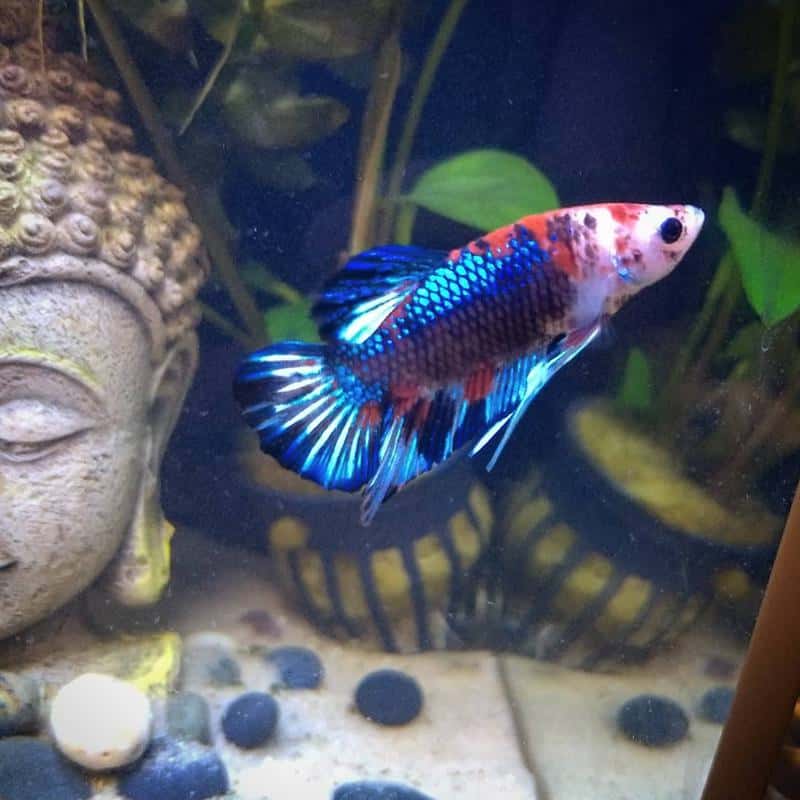
Plakat Koi Bettas are simply Plakats with Koi coloration. They’re arguably the most popular type of Koi Betta since many people love how they look. Their vibrant colors and unique patterns can certainly make your tank pop.
Plakat Koi Bettas can have any of the color combinations listed below. For instance, there are Galaxy Plakat Koi Bettas and Candy Plakat Koi Bettas.
Candy Koi Betta
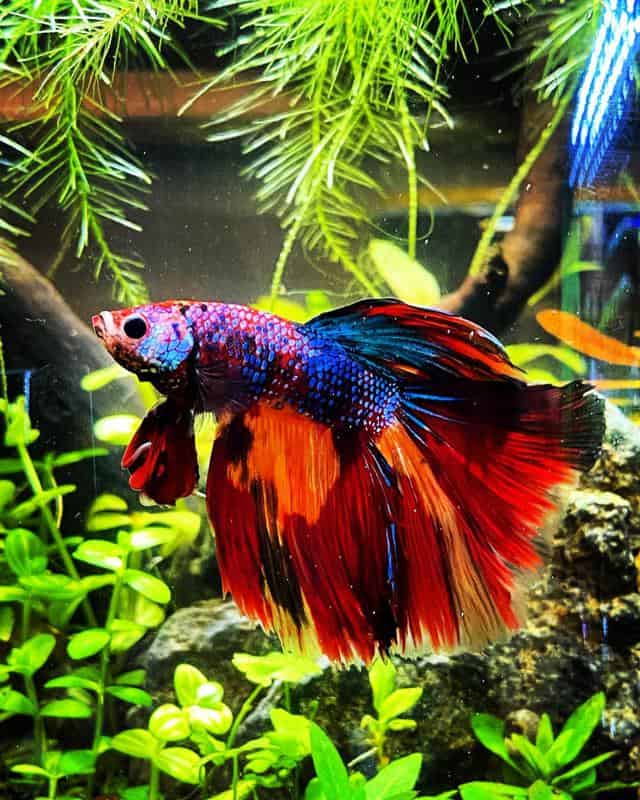
Candy koi bettas are typically red, black, white, and yellow/orange. They appeal to many aquarists in the hobby because of their lovely color combinations.
The “candy” in their name was given because their vivid and unnatural colors resemble the colors you’d expect from candies.
Galaxy Koi Betta
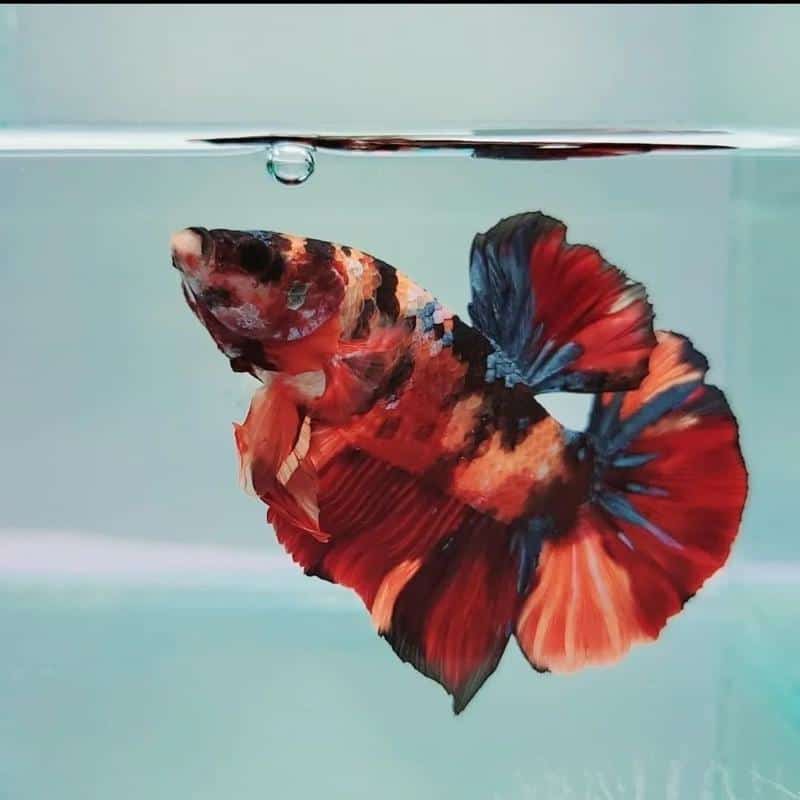
Male Koi Galaxy Bettas have distinctive colors and big blue patches on their bodies. Scales that are often vivid and iridescent blue to turquoise in coloration.
The males of any koi betta type will have more vibrant colors and longer ventral fins, and the same is true for galaxy koi bettas.
Copper Koi Betta
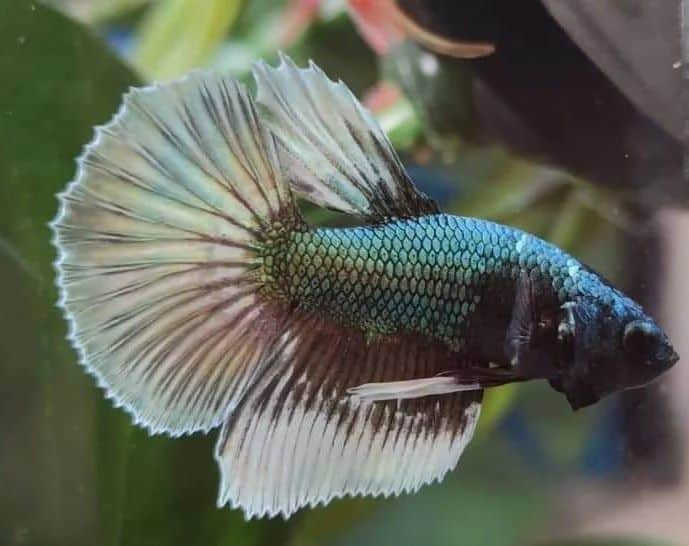
The copper koi betta is a name given to koi bettas with copper, fancy, gold, and orange coloration. They have an iridescence to their scales, making their colors more striking under direct light.
Tangerine Koi Betta
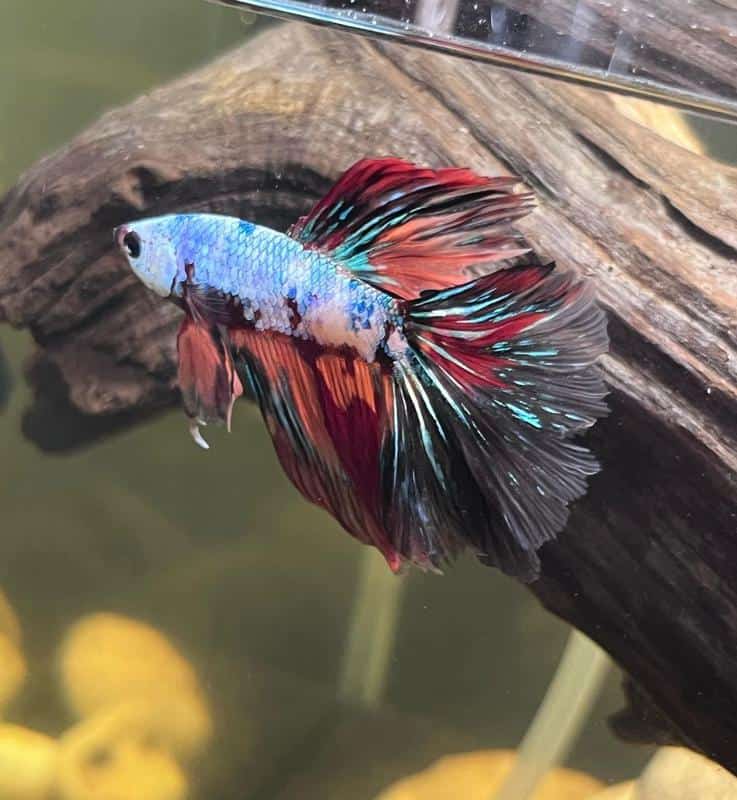
The Tangerine Koi Betta can be found in many hues and designs. One fish may occasionally exhibit five or more colors, making them among the most exquisitely colored bettas now available.
Nemo Koi Betta
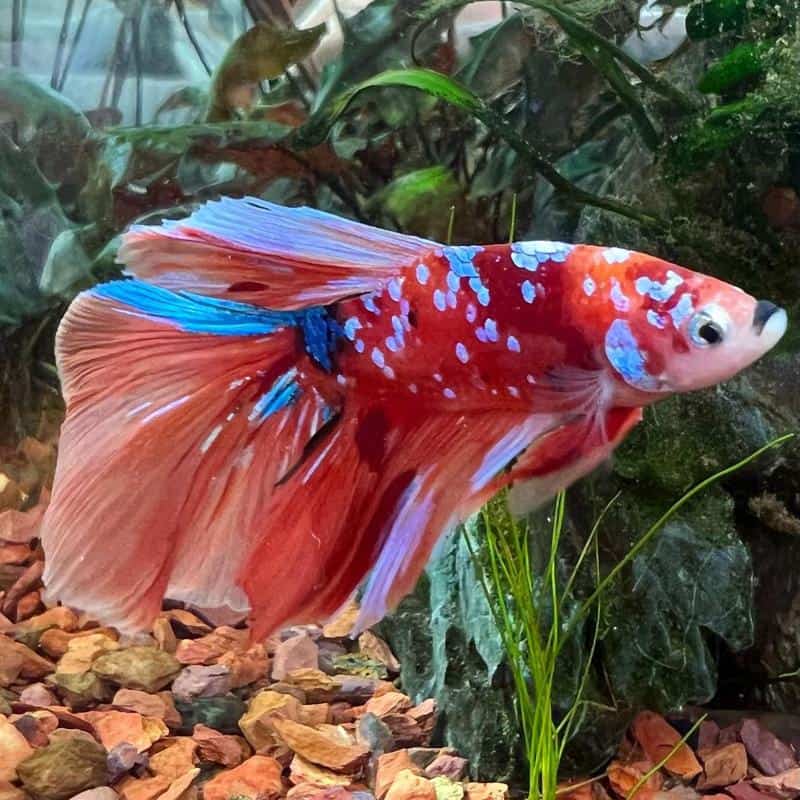
The nemo koi betta is a very colorful fish. The color combinations of this fish’s specimens vary, and they frequently show five or more colors on a single fish. These colors often come in orange, black, white, and other color variations.
Although every betta is different and one of a kind, every specimen of this species is vividly colored.
Tiger Koi Betta
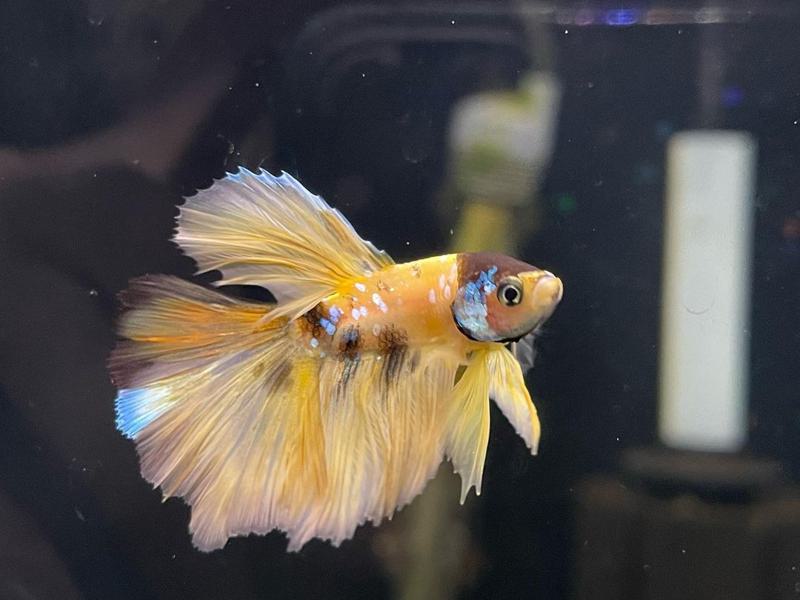
Tiger koi bettas are predominantly characterized by lines of light-on-dark or dark-or-light scales. This means that, for example, the betta might have a yellow body with black or blue stripes or a blue body with yellow or orange stripes.
It’s also important to note that the stripes don’t have to be that well-defined in a tiger koi betta.
Related:
- Types of Betta Fish: Tails & Colors for Your Home Tank
- Can Betta Fish Live with Goldfish?
- Can Betta Fish Live Together?
- Why Is My Betta Fish Turning White (Losing Color)?
- How to Breed Betta Fish?
- Elephant Ear Betta
All You Need to Know About Koi Bettas
As you can see, koi bettas are among the most popular betta fish varieties because of their unique and exciting coloration.
While they don’t differ much from regular bettas, it’s still important to know what koi bettas are, how to classify them, how to differentiate between males and females, and the various types available to you.
This article has provided you with all the necessary information to pick and raise the right koi betta variety for you. Now all you need to do is a trip to the fish store!
